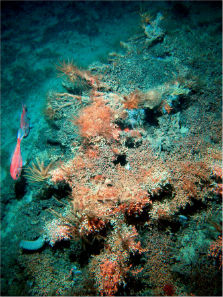Protected coral distribution modelling 2014
Published:
December 2014Download the publication

Deep sea stony corals and orange roughy
POP2013-05 Protected coral distribution modelling 2014 final report (PDF, 3,331K)
Summary
The estimated distributions of protected coral species within the New Zealand Exclusive Economic Zone (EEZ) were updated and refined using the habitat suitability modelling technique of Boosted Regression Trees (BRT). The revised predictive models incorporated recently constructed environmental grids for seafloor saturation levels of aragonite and calcite; forms of calcium carbonate integral to the formation of the calcareous endoskeletons of cold-water corals. The new models focussed more on distributions of individual species and genera than on combinations of structural forms considered in earlier models. The modelled taxa comprised four species of reef-building scleractinian corals, four genera of alcyonacean corals, and four genera of antipatharian corals.
After examination of correlations between all pairs of the available environmental predictors, ten were chosen for inclusion in the BRT model runs. These were similar to the set of variables used in earlier models, except for the inclusion of the new carbonate variables and the exclusion of the bottom depth variable, which was highly correlated with several other variables.
The resultant models generally showed relatively high discriminatory power, with those for taxa at finer taxonomic resolution (species) tending to perform better than those at a coarser level (genera and order). The variables with the most influence across all of the models were dynamic topography and bottom temperature. Dynamic topography (a measure of sea-surface height) is considered a proxy for nutrient supply and probabilities of coral habitat occurrence were strongly positively correlated with this variable, as they were in the earlier models. Temperature is a critical driver of cold-water coral distribution and its importance in these models probably reflects the thermal tolerances of the coral species examined. Surprisingly, aragonite and calcite saturation levels had only moderate influence in most of the models. As most of the presence records were at locations with supersaturated aragonite and calcite levels, it is possible that saturation values above this level may produce only a limited improvement in the corals’ ability to incorporate these carbonate ions into their skeletons.
Suitable conditions for the reef-forming scleractinian corals, as a group, were predicted to be widespread over the EEZ, with higher probabilities on the eastern Chatham Rise and along slopes, ridges, and features of the sub-Antarctic, North Island, and northern parts of the EEZ. Individually, Goniocorella dumosa habitat was more restricted, with the most suitable conditions focussed around the shallower parts of the Chatham Rise, and a range of depths in eastern areas of the sub-Antarctic. Madrepora oculata habitat showed a similar distribution to Goniocorella dumosa in the sub-Antarctic but was predicted to be more common in deeper water on the Chatham Rise. Larger regions of high habitat suitability were predicted for Solenosmilia variabilis and Enallopsammia rostrata, mainly in isolated patches on the sub-Antarctic Plateaux, the northeast Chatham Rise, and northern parts of the EEZ.
For alcyonacean taxa, high habitat suitability for Keratoisis and Lepidisis was predicted in relatively few areas, limited mainly to narrow depth bands on the Chatham Rise and isolated patches in the sub-Antarctic and on northern ridge features. High habitat suitability for Primnoa spp. and Paragorgia spp. was predicted in the Bounty Trough and Bounty Plateau, and in parts of the sub-Antarctic slope. Low suitability for alcyonaceans was predicted over much of the Chatham Rise and, for Primnoa especially, in northern areas.
For antipatharians (black corals) as a group, low habitat suitability was predicted over much of the EEZ, with higher probabilities restricted to the northwest Chatham Rise and some features and major ridges in the north of the EEZ. Individually, high presence probabilities for Leiopathes spp. and Triadopathes spp. were restricted to northern areas, while Parantipathes spp. and Bathypathes spp. showed similar patterns to the combined antipatharians.
A substantial overlap between predicted coral habitat and the 20-year trawl footprint (>50%) occurs across the entire EEZ for Goniocorella dumosa, with lesser overlaps (<25%) for Enallopsammia rostrata, Primnoa spp., and Bathypathes spp. On the Chatham Rise, overlaps of >50% occur for Goniocorella dumosa, Solenosmilia variabilis, Madrepora oculata, and all genera of antipatharians except for Bathypathes. For all taxa, however, substantial areas of suitable habitat are predicted to exist across the EEZ outside of the historic trawl footprint.
Publication information
Anderson, O., Tracey, D., Bostock, H., Williams, M., and Clark, M. 2014. Refined habitat suitability modelling for protected coral species in the New Zealand EEZ. Report prepared by the National Institute of Water and Atmospheric Research for the New Zealand Department of Conservation, Wellington. 46p.
Contact
Conservation Services Programme
Department of Conservation
PO Box 10-420
Wellington 6143
Email: csp@doc.govt.nz
